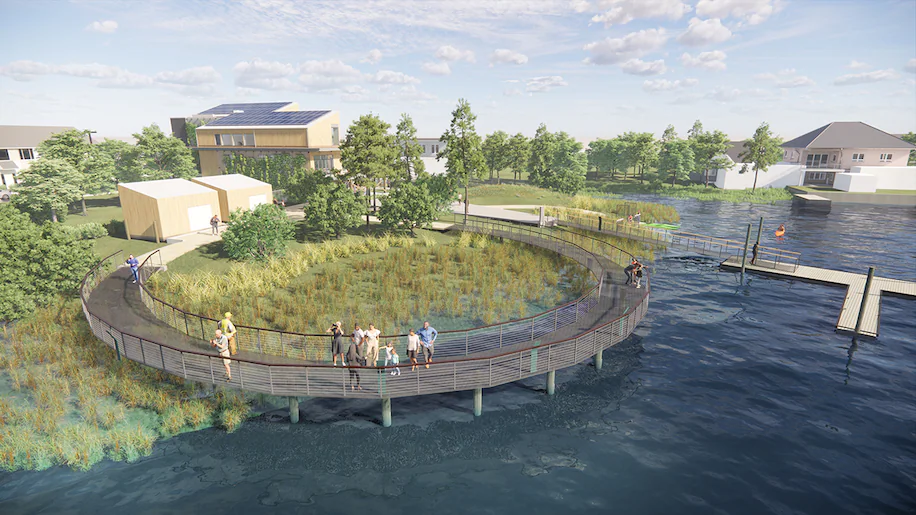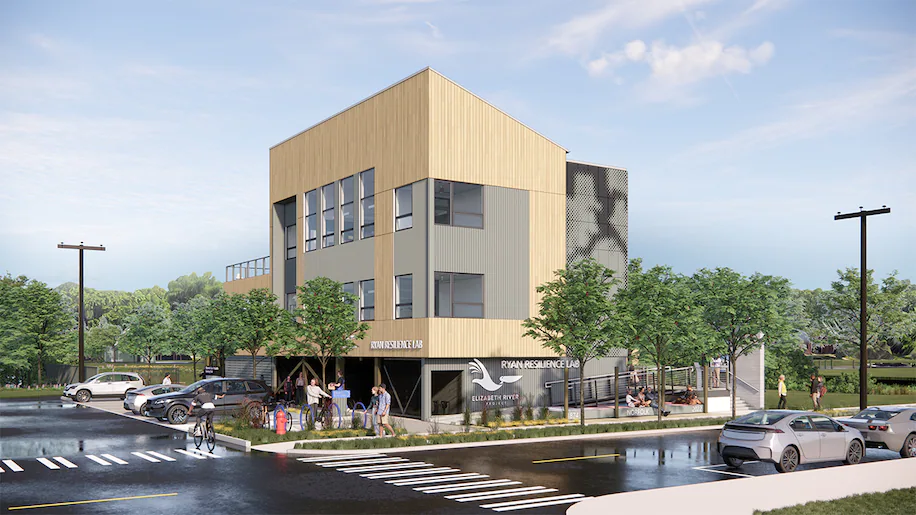
(Work Program Architects)
Rising waters have been a problem with all coastal cities and flooding has occurred. This is a building that is designed for flooding.
As coastal cities wrestle with increasing threats from rising waters, a nonprofit’s costly new headquarters offers an answer that is both defiant and prescient. The Elizabeth River Project’s $8.1 million headquarters on a flood plain destined to be submerged in the coming decades as tides rise and storms intensify has been designed to showcase strategies to stay longer in harm’s way. Eventually it will surrender to the inevitable: The environmental group has agreed to demolish the building and abandon the site. “It’s intended to show you how to work and play and live with this rising sea level,” said Marjorie Mayfield Jackson, who co-founded the Elizabeth River Project 25 years ago to restore the waterway. “And once it’s no longer functioning, we take down the building and give it back to nature, give it back to the river.”
washingtonpost.com
Climate change is coming and more than half of the people thing it is harming them.
Polls show more than half of Americans think they are being harmed by climate change. That number jumps in places already feeling its effects like Norfolk, where a poll shows three-quarters of the population is worried about the risk. Yet worrying about the problem is one thing, facing the reality is another. The novel experiment to build a sort of resilience theme park for homeowners and developers, destined for destruction, aims to ease people into confronting that reality. “This whole corridor is at risk, but culturally vital,” said Sam Bowling, the architect for Work Program Architects who spearheaded the design. “All these people live and work and have their favorite bars along Colley Avenue. They don’t want to leave. They’re aware of the risks.” Construction on a small creek will be complete next year, Mayfield Jackson said. A 6,500-square-foot laboratory will be raised 11 feet on an avenue resurgent with restaurants, a brewery and small businesses. Strategies to reduce the building’s environmental impact are off-the-shelf solutions so they can be replicated by homeowners and developers. A solar array will generate electricity. A green roof and a rain garden will collect water for use in toilets. A southern-facing green wall will reduce the need for cooling in the summer and heating in the winter, bolstered by insulation that exceeds local energy-saving requirements. The lab’s reduced environmental impact will be certified by EarthCraft, a program the designers view as more approachable and affordable to homeowners than the well-known LEED certification. “We want to show others that there might just be a better way to live and work in urban areas on the coast, despite rising seas,” Bowling added.

(Work Program Architects)
This is a new approach where a private land owner takes such a step.
The site marks the first time a U.S. private property owner has agreed to a rolling conservation easement, according to the representative of the land conservation trust working with the nonprofit, which acknowledges that rising waters will overtake the land. When certain trigger points like repeated flooding are reached, the land is returned to nature forever. A.R. Siders, an assistant professor in the Biden School of Public Policy and Administration and a member of the University of Delaware’s Disaster Research Center who studies adaptation to climate change, said policies like these could make it easier for people to move away from threatened areas. She points to the collapse of Outer Banks homes on an eroding shoreline that spread debris 15 miles down the beach this spring after a storm. “Wouldn’t it be better to have a plan to dismantle those homes and take them away before they cause debris over miles of beach?” she asked. A rolling easement, she added, makes what seems unpredictable predictable. For a city, the easements mean it reaps the tax benefits of permitting building in a vulnerable area but understands that comes with an expiration date.
The city would have to update their zoning laws to cover this idea.
Norfolk officials say the site shows ways to comply with the city’s updated zoning ordinance, which awards new developments points for resilience to climate effects. At the site, restored wetlands featuring native grasses and an oyster reef will mitigate flooding and prevent erosion. Pervious paving and rain gardens will absorb and store rainwater, keeping it out of the city’s overwhelmed storm water system. “We’ve been supportive of this,” said Kyle Spencer, Norfolk’s acting chief resilience officer. “We’d like to see ourselves as this sort of living laboratory to work through these really complicated, tough issues cities like ours are facing.” Mary-Carson Stiff, a board member of the Living River Trust, a nonprofit conservation effort that will enforce the easement, said it offers a potential solution to the coming conflict between rising waters and private property rights in cities like Norfolk, where portions of the waterfront will become uninhabitable. Rolling easements are used in a few states, but only by public bodies. In Texas, they protect access to public beaches. As the mean low tide naturally shifts, the public’s right to access moves, as well. In Maine, they protect dunes by prohibiting sea walls and requiring their removal as the shoreline moves.

(Work Program Architects)
This idea has been alive since the 1990’s as the EPA had internally fought the concept.
The idea was first championed in the 1990s by James Titus, a sea-level rise expert at the Environmental Protection Agency who clashed with agency officials over his repeated calls to address the problem. As waters threaten, private property becomes public under the public trust doctrine — the legal principle that the government owns natural resources like rivers and shorelines. “There’s no legal framework to address the large-scale changing ownership of a coastline as sea levels rise,” Stiff said. “I see the rolling easement as the instrument to address what will be an incredible legal challenge in the future.” By agreeing to rolling easements, property owners get tax benefits from the federal government and from some states, Stiff said. For now, state and local governments face expensive buyouts and potential court battles.
The idea was tried by local authorities in 2009 but lost in court.
In 2009, a hurricane damaged cottages along the beach in Nags Head, N.C., and the town ordered their permanent removal, saying they sat on public trust land and declaring them public nuisances. The owners sued. After years in court, Nags Head lost and settled for $1.5 million. Why haven’t easements become common since Titus started talking about them more than two decades ago? Jesse Reiblich, who was recently a postgraduate law fellow at William & Mary and examined easements while a fellow at Stanford University’s Center for Ocean Solutions, said it will take “property owners realizing that they are waging a losing battle. That hasn’t happened yet on a large scale.” Decades from now, either climbing sea levels or frequent floods will prompt the Elizabeth River Project to tear down its headquarters. What can be recycled will be recycled, connections to utilities like water, sewer and electrical will be removed, and nature will again rule the land. For Mayfield Jackson, it’s fitting for a creek that is slowly recovering from the devastation of industrialization. “We’re not just showing how to do it right for humans and businesses,” shesaid, “but to safeguard the river, too.”
An interesting idea especially if you are built on the water side. But other ideas mentioned could be used here to make us more resilient.
